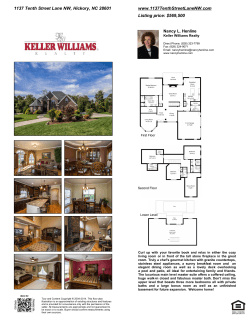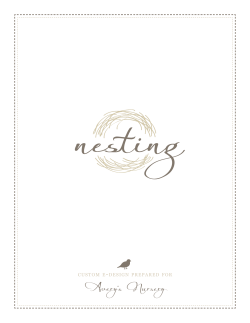
Document 287143
Series #1: The Classroom Environment Tips for Tots ® Did you know? Tip #1: Create a Quiet Space Strategies Infant/Toddler: Infant/Toddler: Infants and Toddlers often need a soft, quiet, protected place where they can relax and have some space away from loud or busy areas in the classroom. Teaching children to soothe themselves by going to a ‘cozy area’ can help them feel comforted and better able to cope. They may benefit from a ‘cozy area’ to be by themselves while they adjust to events such as drop off or overly noisy activities such as movement or music. • Infant and toddler rooms strive for a comfortable and comforting environment which is more homelike than a typical classroom. These classrooms have soft surfaces and places to sit, lie down, and cuddle up for infants and toddlers seeking comfort and cuddling. • Provide a ‘cozy area’ in your classroom that is easily accessible. Allow children to use the ‘cozy area’ freely. This is an area with soft surfaces, cuddly toys, some cushions, a cozy rug, a blanket, and a little sofa or chair. Have a few books available that children can look at and perhaps a toy or two that gives the child the option of some music. • Self-soothing is an important skill for children to learn. Some children may need time alone to soothe themselves. These are children who may refuse the comfort of a caregiver. They may cry a little, suck a pacifier or thumb, and after a little calming time, rejoin the group willingly. A soft cozy area that children can go to easily can help with this self-soothing process. Preschool: Preschoolers may need quiet time for themselves at different points of the day. A full day of childcare can be stressful and difficult to manage for some young children. A ‘be-bymyself’ space can be set aside in the classroom for a child to use when he or she feels overwhelmed, upset, or tense. This serves as a protected place where children are taught to go to in order to relax, calm down, or take a break. A teacher can join the child, if he or she needs support in calming down or feeling secure. Resources: List several resources Here Organizing Classroom and Outdoor Learning Environments web sites White, C. S., & Coleman, M. (2000). Books Soft Spaces http://www.communityplaythings.com/ Videos Services resources/articles/softspaces/index.html Contact your area ECCP Consultant for free Early Childhood Mental Health Consultation services: To learn of the consultant in your area please call: ECCP at (860) 704-6378 Preschool: • Consider creating with children a ‘be-by-myself ‘space or ‘cozy area’ within a small contained area in your classroom (ex. play hut, tent, cushioned space, etc.). You may include items such as, pillows, a bean bag chair, feelings books, and photos. Be sure this area is visible to teachers. • View this as a quiet, protected place where a child can choose to go if he or she becomes overwhelmed, upset, or angry. Teachers may also encourage a child to go to this space. It is important that this is not used as a consequence or “Time Out.” • Teach children how to use this area ahead of time, creating rules, such as ‘one at a time.’ Continue to make this an important part of your classroom by reviewing what it is for, modeling, and making periodic changes to keep it interesting. • Practice relaxation techniques with children ahead of time, such as blowing up like a balloon, stretching or counting to ten on his or her fingers, suggest he or she repeat these things in the ‘be-by-myself’ space or ‘cozy area’. Place visual reminders of these techniques in the cozy area. Brought to you by ECCP Early Childhood Consultation Partnership© A program of Advanced Behavioral Health www.abhct.com Funded by CT Department of Children & Families
© Copyright 2025










